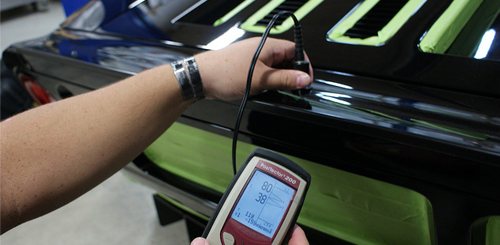Only an ultrasonic thickness gauge, such as the Defelsko 200 Advanced, can read on composite materials like carbon fiber, fiberglass, and plastic, so if you’re a discerning owner who treasures your vehicle, or you have a high dollar automobile you would like worked on, it would be in your favor to either have an ultrasonic thickness gauge available, or to make sure your paint correction and detailing professional has uses one in order to properly polish your car. In this article, I’ll explain why.
Why ultrasonic?
An ultrasonic thickness gauge allows for much safer polishing of non-metal surfaces such as carbon fiber, plastic, and fiberglass by giving the person doing the polishing the knowledge of how thick or thin the paint he or she is working on is. Traditional thickness gauges can only read on ferrous (steel) and non-ferrous (aluminum) panels limiting their use to certain vehicles or certain panels. Being able to read the thickness of the paint on all surfaces can better educate an owner and detailer on the history of the vehicle and correctly advise in favor or against machine polishing and paint correction.
Taking paint readings on a plastic side mirror.
Background:
Techniques, products, and tools of professional detailing have improved greatly in the last decade. Ten years ago you would have been hard pressed to find major paint correction work being done with Dual Action polishers as rotary polishers were king, nor would you have seen such a large amount of operators using paint thickness gauges to take readings prior to beginning polishing. Instead operators had to “polish on a prayer.” Changing technology, greater understanding and harnessing of information and technology, competition, and the drive to put out the best work possible has led many quality professionals to consistently search for better, safer, and more effective ways to bring their client’s vehicles to better-than-new condition. A Defelsko 200 Advanced gives an operator a better understanding of the paint he or she is working on, allowing that operator to give a better and more accurate opinion to the owner that is backed with not only experience and know-how, but with scientific data as well.
Measuring a composite pillar.
A Vehicle Owner’s Point of View:
As an owner that is looking to have professional paint correction and detailing performed on your vehicle, you have many options on who to choose and why. There are two main concerns with having someone work on your vehicle, and the order is always the same:
1. Safety
2. Results
No owner wants a more shiny car at the expense of something breaking, going wrong, or needing to be repainted. I’ve personally found that in the event of a concentration of deep defects, most owners agree with my feeling to “only remove what you can safely remove, and we’ll worry about what remains when the vehicle is polished again in the future.” This echoes the idea that safety is always the highest priority as it should be. Even when wet-sanding and aggressive polishing is performed, it should be done in a very calculated and methodical manner to increase the safety of the procedure; lowering the risk and potential for damage. Even the idea of choosing a highly recommended and experienced detailer is to give your car the right results without jeopardizing your baby’s safety. An ultrasonic thickness gauge is another major step forward in safety.
With increased safety comes increased results. That little scratch? Not removed on purpose. That beautiful swirl-free paint? Properly polished, and done so while making sure the paint is healthy enough for future polishing as well. Anytime you can remove guessing from the work performed on your vehicle, you’re going to be able to achieve superior results.
Measuring a plastic bumper.
A Professional Detailer’s Point of View:
As a detailer in an ever more competitive business, getting a leg up on the competition is always useful. Having an ultrasonic thickness gauge like the Defelsko 200 Advanced allows you to prove your dedication to safety as well as your commitment to achieving the best results possible. If you work on exotics, or fiberglass cars, it might be the only way you can read paint thickness for some of your clients.
My first step to getting the following 50/50 picture of heavy paint correction on a Porsche Carrera GT?
It all started with making sure the paint covering this carbon fiber body was healthy enough for such a procedure.
Not all cars or clients are going to end up with a massive turn around on exotics or supercars, but to maximize the work you do perform, you first should take the health and safety of the car into account.
If you believe that better knowledge and safer techniques can lead to better results, I’d recommend you consider adding this piece of equipment to your bag of tricks. While expensive, it is a small fraction of the value of the vehicles it will no doubt be used on.
Carbon kevlar Vector W8 Twin Turbo we helped to prep for the Meadowbrook Concours d’Elegance of 2010 with her happy owner.
